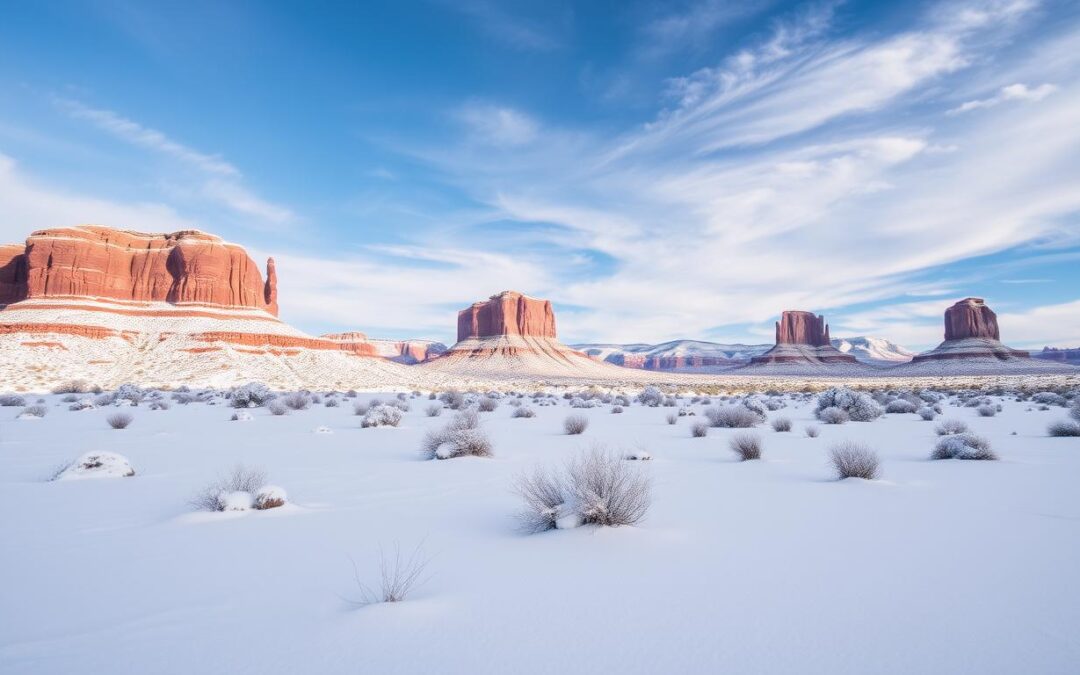St. George, Utah, is a unique desert spot with interesting weather. It’s in the southwestern part of Utah. This city has a climate that surprises people who look for snow.
People often wonder if it snows in St. George during winter. While it doesn’t snow much in the city, the mountains nearby get snow. This makes the desert look like a winter wonderland.
Key Takeaways
- St. George features a subtropical desert climate with minimal snowfall
- Winter temperatures typically range from the 30s to 50s °F
- Upper elevation areas experience more snow than valley regions
- Winter activities remain diverse despite limited snow accumulation
- Nearby mountain ranges offer alternative snow experiences
Understanding St George’s Unique Geographic Location
St. George is in a special spot that greatly affects its weather. It’s in southwestern Utah, with a landscape unlike other places. This location leads to interesting weather patterns that catch the eye of both locals and visitors.
Distance from Major Cities
St. George is close to big cities, which is interesting. It’s about:
- 188 kilometers northeast of Las Vegas, Nevada
- 488 kilometers southwest of Salt Lake City, Utah
- Coordinates: 37°04′30″N 113°34′36″W
Elevation and Topographical Features
The city’s height is key to its weather. At 2,530 feet above sea level, St. George’s climate is different from higher places in Utah.
| Geographical Characteristic | Measurement |
|---|---|
| Total Area | 77.151 square miles |
| Land Area | 77.148 square miles |
| Water Area | 0.003 square miles (0.72%) |
Impact on Local Climate
The area’s features make a special microclimate that affects the weather. St. George gets over 300 sunny days a year. It has little snow compared to other Utah areas. The low elevation and desert surroundings make it warm and dry.
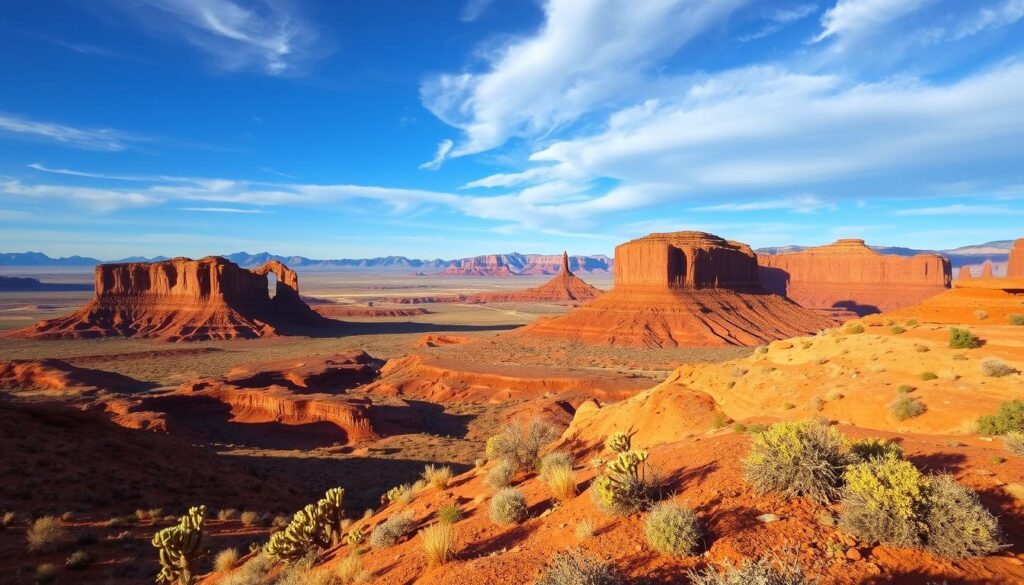
“St. George’s location offers a unique blend of desert warmth and mountain proximity, creating a climate unlike any other in Utah.” – Local Geographer
St George’s Climate Classification
St. George, Utah, has a unique subtropical arid climate. This climate is different from many other places in the state. It’s known for its extreme warmth and very little rain.

- Over 300 days of clear skies annually
- Extremely low annual precipitation (approximately 8 inches)
- Extended periods of intense heat
- Minimal winter precipitation
The climate is classified as a hot desert climate. This means very hot summers and mild winters. The area’s temperature changes a lot, thanks to its location.
“St. George’s climate is nature’s contradiction – extreme yet inviting” – Local Meteorologist
The climate in St. George is tough but beautiful. Summers can get over 100 degrees. Winters are mild, with temperatures between 50-60 degrees during the day.
| Climate Characteristic | Measurement |
|---|---|
| Average Annual Temperature | 61°F |
| Annual Precipitation | 8 inches |
| Days of Sunshine | 300+ |
| Heat Risk | Extreme |
St. George’s climate draws many tourists in winter. They come to escape the cold, making the area lively all year.
Does It Snow In St George Utah
St. George gets very little snow because of its desert climate. It’s in southern Utah and rarely sees a lot of snow. Winter weather here is different from other parts of Utah.
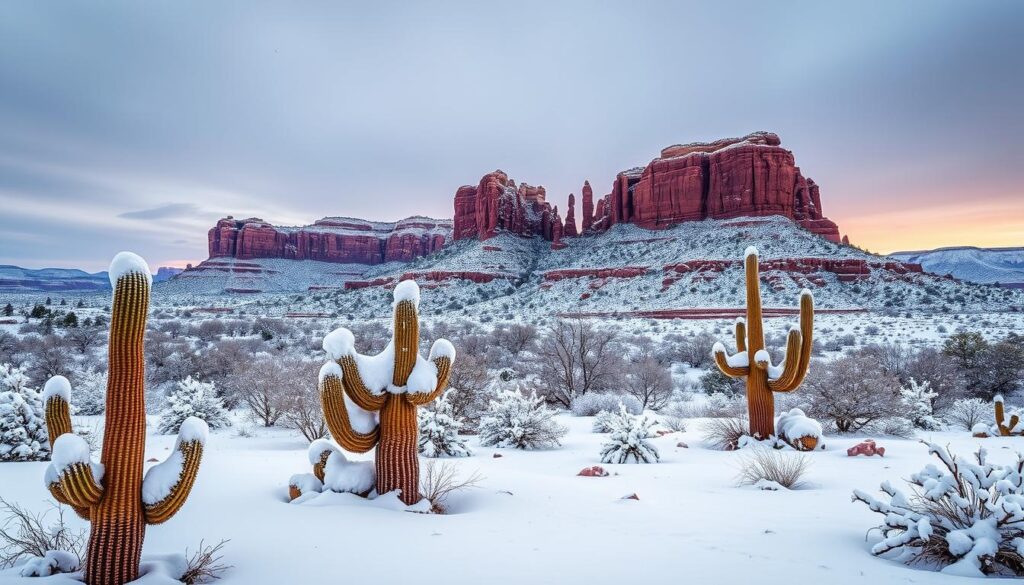
Looking into whether it snows in St. George, Utah, shows it’s rare. The city’s low elevation and desert setting mean little snow falls.
Annual Snowfall Statistics
Winter weather in St. George shows some interesting facts:
- Average January snowfall: About 1.3 inches
- Average February snowfall: Roughly 0.6 inches
- Most winter storms bring little snow
- Snow usually melts quickly after falling
Snow Accumulation Patterns
St. George’s location makes it hard for snow to pile up. Areas around the city might get a light dusting during storms.
Duration of Snow Cover
Snow in St. George doesn’t last long. When it does snow, it’s gone in hours. The sun and warm temperatures melt it fast.
“In St. George, winter is more about crisp, clear days than snow-covered landscapes.”
Winter in St. George means temperatures from the low 40s to the upper 50s. This makes outdoor activities less affected by snow.
Winter Temperature Patterns in St George
St George Utah weather is quite different from many other Utah cities during winter. The temperatures in St George during winter are surprisingly mild. This makes it a great place for both locals and visitors.
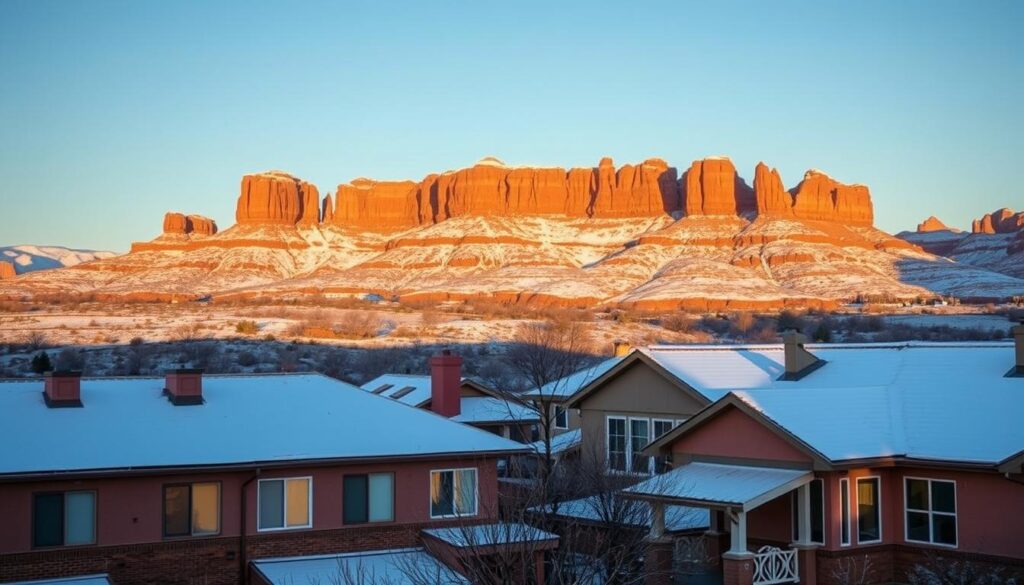
From mid-November to late February, St George’s winter is quite gentle. Early December usually sees daytime highs in the mid-50s and nighttime lows around the mid-30s.
“St George’s winter climate offers a more moderate experience compared to other Utah regions,” climate experts note.
Winter Temperature Breakdown
| Month | Average High | Average Low |
|---|---|---|
| December | 53°F | 33°F |
| January | 54°F | 32°F |
| February | 60°F | 37°F |
St George’s winter temperatures have some key features:
- Rarely dropping below 22°F
- Consistent mild daytime temperatures
- Short duration of cold weather
The city’s location adds to its mild winter. This makes St George a great choice for those who want a milder winter.
Seasonal Weather Transitions
St George Utah sees unique seasonal changes that alter the landscape and climate all year. These changes are fascinating and attract both locals and visitors.
Fall to Winter Progression
As autumn comes, St George notices cool weather changes. Late September starts with cooler days, with highs falling from 92.6°F to more comfortable levels. Key changes include:
- Temperatures drop from 80.2°F in October to 64.8°F in November
- Precipitation slightly increases from 0.68 inches in October to 0.64 inches in November
- Daylight hours get shorter
Winter to Spring Transformation
The winter-to-spring change in St George is quite dramatic. By early March, temperatures start rising quickly, welcoming spring. The changes are:
- Daily average high temperatures rise from 53.6°F in January to 67.9°F in March
- Daylight hours increase by about 2 minutes each day
- Cloud cover drops from 42% to 23% in spring
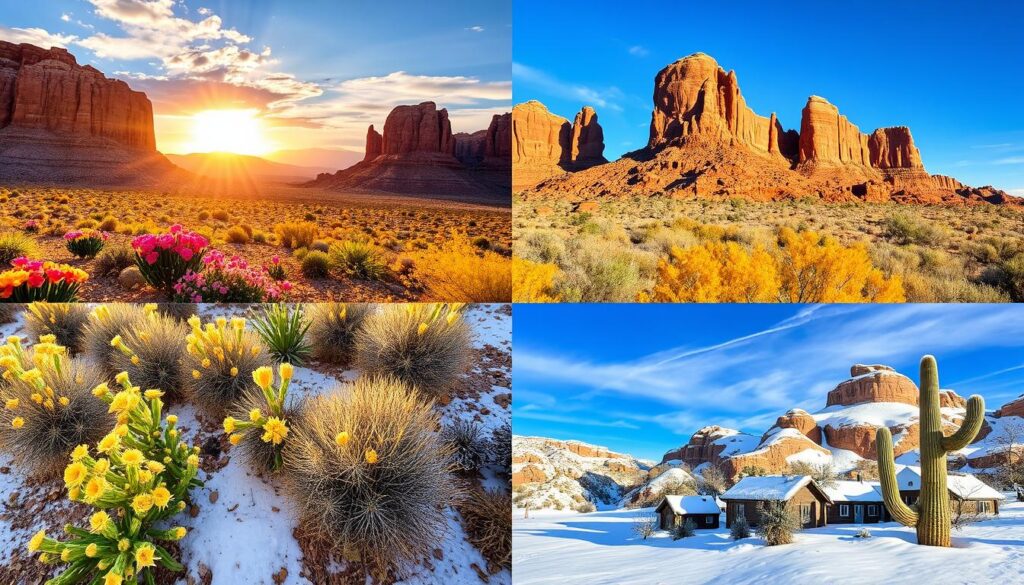
*”The beauty of St George lies in its subtle yet remarkable seasonal changes”* – Local Weather Enthuasiast
The seasons in St George show nature’s amazing ability to change landscapes. This offers a dynamic and engaging climate experience for everyone.
Monthly Temperature Variations
St. George Utah sees big changes in temperature all year. This makes its climate special and interesting for both locals and visitors. The area goes from cool winters to very hot summers, showing its wide range of weather.
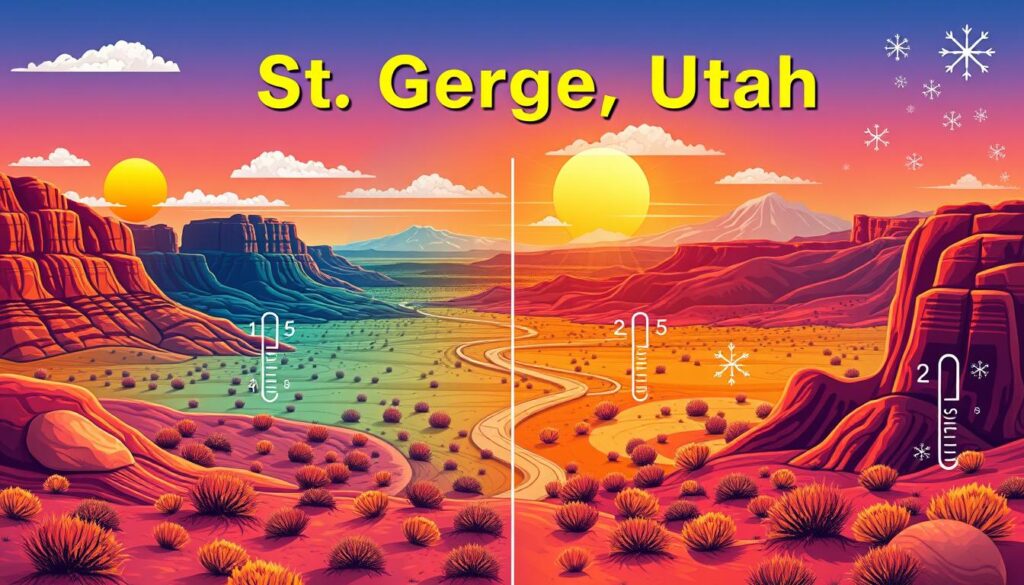
In winter, St. George is quite mild. January’s lows are 31°F, and highs are 52°F. As spring comes, the weather gets warmer and more comfortable.
Seasonal Temperature Breakdown
- Winter (December-February): Coolest period with temperatures ranging from 31°F to 52°F
- Spring (March-May): Temperatures gradually warm up, reaching mid-60s
- Summer (June-August): Extreme heat with temperatures soaring to 102°F
- Fall (September-November): Gradual cooling from summer peaks
| Month | Average Low | Average High |
|---|---|---|
| January | 31°F | 52°F |
| July | 76°F | 102°F |
| May | 55°F | 86°F |
“St. George’s temperature variability makes it a fascinating destination for weather enthusiasts and outdoor adventurers.” – Local Meteorologist
The area’s weather changes a lot because of its location. Its height and the shape of the land around it affect the temperature. Summers are very hot, but winters are not as cold as in other parts of Utah.
Precipitation Patterns Throughout the Year
St. George, Utah, has a desert climate with little rain and clear seasonal changes. It’s a semi-arid area with very little moisture all year.
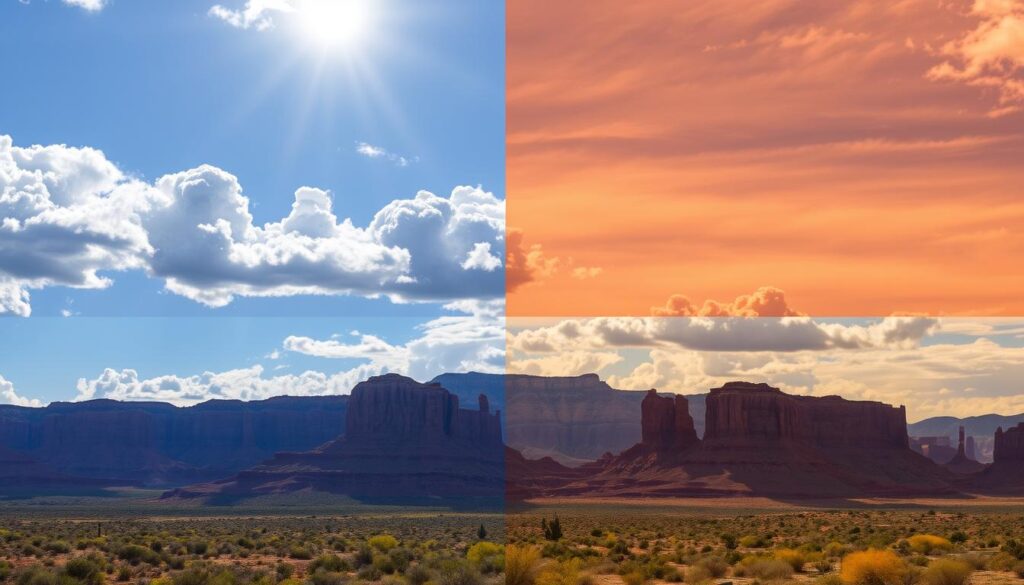
The city gets about 209 mm of rain each year. This makes it a low-rainfall area. Knowing about the rain helps locals and visitors plan better.
Rainfall Distribution
St. George’s rain changes with the seasons:
- December is the wettest month, with about 33 mm of rain
- June is the driest, with just 2.1 mm of rain
- Spring brings 39% of the year’s rain
- Fall is the driest, with only 16% of the rain
Moisture Sources
The rain in St. George comes from different places:
- Winter storms from the Pacific
- Summer monsoons from the Gulf of California
- Occasional atmospheric river events
St. George gets rain about 43 days a year. Most of it falls during the spring and fall.
“St. George’s rain patterns show the fine balance of a desert ecosystem. Every drop of water is a story of survival.”
| Month | Rainfall (mm) | Rainy Days |
|---|---|---|
| January | 31.86 | 3 |
| February | 33.00 | 5 |
| June | 2.10 | 1 |
| December | 33.00 | 3 |
Knowing about St. George’s rain helps us understand its special climate and how life adapts here.
Comparing St George Snow to Other Utah Cities
Utah’s snow landscape is quite different in the south and north. St. George is a unique winter spot with little snow. Other Utah cities get a lot more snow.
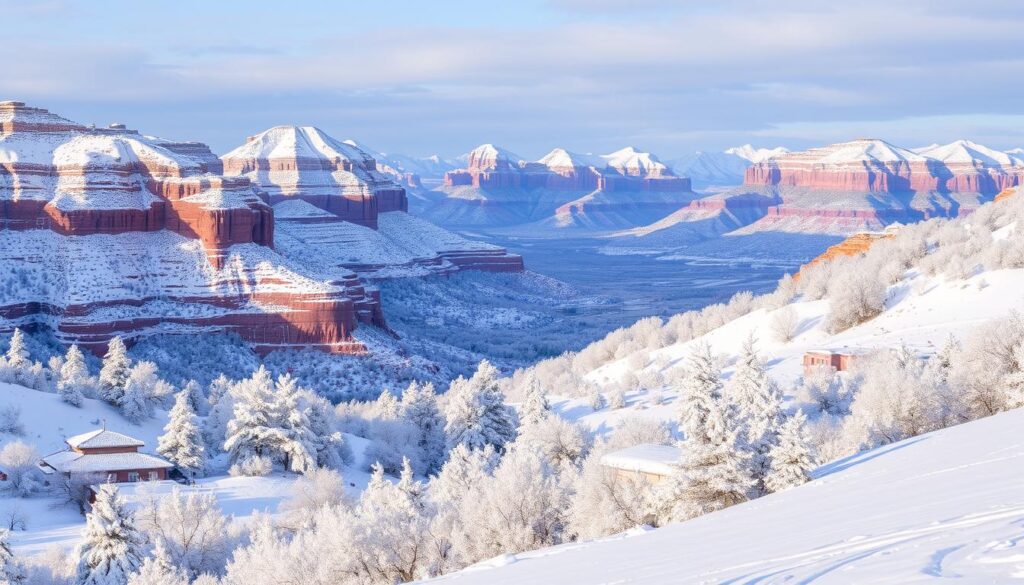
Looking at snowfall in Utah, we see big differences. St. George gets just 1.5 inches of snow a year. But, nearby mountains get a lot more.
| City | Annual Snowfall | Sunny Days |
|---|---|---|
| St. George | 1.5 inches | 255 days |
| Salt Lake City | 53.6 inches | 222 days |
| Brian Head Resort | 300+ inches | 210 days |
Southern Utah’s snow patterns show how elevation changes winter weather. Places like Brian Head Resort, higher up, get lots of snow. It’s great for those who love winter sports.
- St. George: Low-elevation, minimal snow
- Pine Valley Mountains: Significant winter snowfall
- Brian Head: Consistent powder snow conditions
“The beauty of Utah lies in its diverse microclimates, where within a short drive, you can transition from desert warmth to alpine winter landscapes.”
Being close to mountains, St. George folks can enjoy winter sports. They don’t have to stay cold and snowy at home.
Impact of Elevation on Local Weather
Southern Utah’s landscape is unique, leading to big weather changes with elevation. St George utah weather shows how high up you are affects rain and temperature. The area’s varied heights greatly shape the local climate.
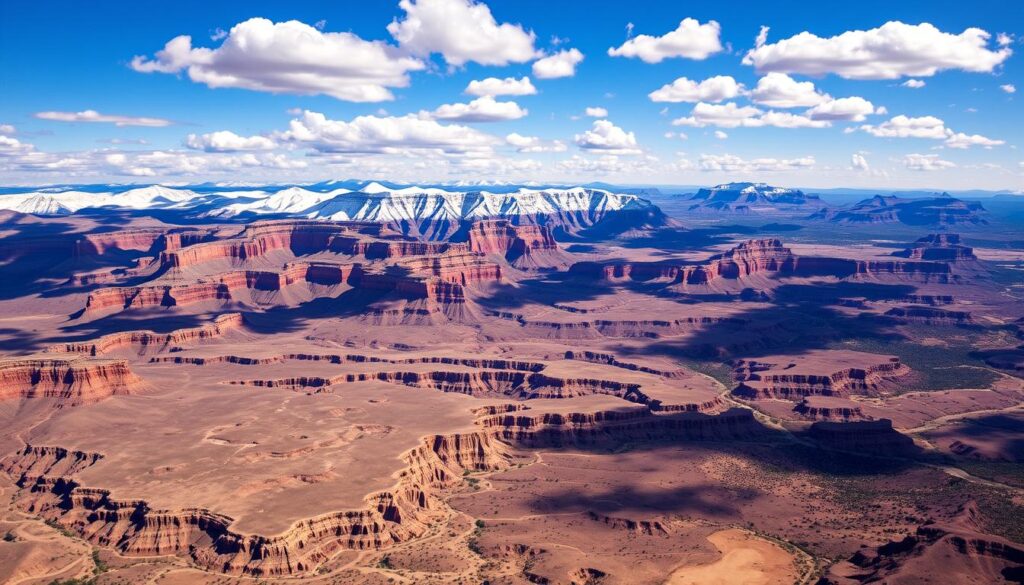
Elevation changes weather a lot in southern Utah. St. George, at 2,500 feet, is lower than many areas around it. This leads to big climate differences.
Valley and Mountain Weather Contrasts
The temperature in southern Utah shows interesting changes:
- St. George valley stays mild in winter
- Mountain areas get a lot of southern utah snow
- Small changes in elevation create different climates
Temperature Gradients Explained
Utah’s landscape sees about 3°F drop in temperature for every 1,000 feet up. This leads to unique weather in different areas.
| Elevation | Temperature Impact | Precipitation Likelihood |
|---|---|---|
| 2,500 feet (St. George) | Mild winters | Low snowfall |
| 5,000-7,400 feet | Cooler temperatures | Moderate snow |
| Above 8,000 feet | Cold winters | High snowfall |
Zion National Park, above 7,400 feet, often sees winter snow. St. George stays warmer.
“Elevation is the silent architect of weather patterns in southern Utah.” – Local Climate Researcher
Winter Activities Despite Limited Snowfall
St. George Utah weather offers a unique winter experience. It doesn’t rely on lots of snow. Instead, it has plenty of outdoor fun for everyone.
The st george winter conditions are perfect for outdoor fun. People can try many activities. Here are some:
- Hiking in Snow Canyon State Park
- Mountain biking on desert trails
- Rock climbing in mild winter temperatures
- Golfing at one of 13 local courses
- Off-highway vehicle (OHV) adventures
Southern Utah’s winter is special. It has over 300 sunny days a year. This means great weather and amazing views for outdoor fans.
| Activity | Location | Winter Accessibility |
|---|---|---|
| Hiking | Snow Canyon State Park | Year-round |
| Golf | Greater Zion Area | Continuous |
| OHV Riding | Coral Pink Sand Dunes | Winter Permitted |
“Winter in Southern Utah isn’t about snow—it’s about experiencing nature’s incredible diversity.” – Local Adventure Guide
St. George is a great place for winter fun. It’s not like other places with lots of snow. Here, the mild weather and beautiful views make winter unforgettable.
Nearby Snow Destinations
Travelers looking for more snow than St. George can find it nearby. Several winter spots are just a short drive away. These places offer amazing snowfall opportunities in the mountains.
Southern Utah has many snow-focused spots. They are all within a short drive from St. George. Each offers a unique winter experience.
Brian Head Resort
Brian Head Resort is a top choice for snow lovers. It’s about 90 minutes from St. George. The resort sits at 9,600 feet, guaranteeing good snow.
- Elevation: 9,600 feet
- Distance from St. George: 90 minutes
- Winter activities: Skiing, snowboarding, snowshoeing
Pine Valley Mountains
The Pine Valley Mountains are another great snow spot. They offer beautiful snow scenes and lots of outdoor fun.
| Location Feature | Details |
|---|---|
| Terrain Type | Mountain wilderness |
| Winter Activities | Hiking, snowshoeing, photography |
| Snow Accessibility | Moderate to high |
Pro tip: Always check local weather conditions and road accessibility before planning your winter mountain adventure in Southern Utah.
Spring Weather Characteristics
St George Utah sees a big change in spring. The desert comes alive as winter fades. This change is exciting for both locals and visitors.
Spring in St George Utah is warm fast. By early March, it’s nice and warm, between 60-75 degrees Fahrenheit. Plants start to grow quickly, thanks to winter’s rain.
- Afternoon temperatures rise consistently by late February
- Desert vegetation turns temporarily green
- Winter rains provide essential hydration for local ecosystems
“The desert doesn’t bloom, it explodes with color and life during spring,” local botanists often describe the seasonal transition.
Spring brings interesting rain patterns. Winter rainfall accumulates roughly 3.57 inches from December to February. This rain leads to a short but beautiful desert bloom.
St George’s location makes its spring weather unique. The quick change from winter to spring is amazing. It’s a great time for nature lovers.
Summer Climate Patterns
St George Utah has very hot summers, typical of its desert climate. The temperature in July often hits over 100°F. This makes the summer weather very hot.
Summer in St George brings dry, intense heat with very low humidity. The weather makes it hard to stay outside during the day. Temperatures often go over 100°F.
- Average high temperature in July: 103°F
- Average low temperature in July: 74°F
- Average summer humidity: Around 24%
“In St George, summer is not just a season, it’s an extreme weather experience.”
People plan to go outside early in the morning. They also look for shade during the hottest part of the day. The low humidity helps a bit, but it’s important to stay safe from heat.
| Month | High Temp | Low Temp | Precipitation |
|---|---|---|---|
| July | 103°F | 74°F | 0.49 inches |
| August | 101°F | 72°F | 0.70 inches |
| September | 93°F | 63°F | 0.54 inches |
Even though it’s very hot, St George’s summer has its own special moments. It’s for those who can handle the heat.
Conclusion
Exploring if it snows in St. George, Utah, shows a unique climate. The city’s winters are mild, with snow being rare. With an elevation of 2,800 feet, temperatures in December average in the mid-50s Fahrenheit.
This makes it unlikely for snow to accumulate significantly. The St. George climate is interesting, with temperature inversions and microclimates stopping snow. While mountains nearby get snow, St. George stays dry and warm.
Visitors looking for winter fun can head to Brian Head Resort. It’s a short drive away and offers snow activities. Outdoor lovers will enjoy St. George’s climate, which offers fun all year.
Though snow is rare, the area’s mild weather and lots of sunshine are appealing. The landscapes around St. George change with the weather, giving visitors many experiences in one place.
St. George is a special place where winter doesn’t mean snow. Its climate is a nice change from usual winter places. It invites visitors to see its beauty without the hassle of snow or cold.

